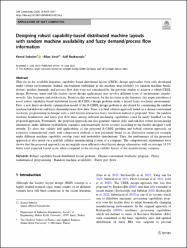Designing robust capability-based distributed machine layouts with random machine availability and fuzzy demand/process flow information
Künye
Subulan, K., Varol, B., Baykasoğlu, A. (2023). Designing robust capability-based distributed machine layouts with random machine availability and fuzzy demand/process flow information, 28, 4359-4397. Springer Science and Business Media LLC.Özet
Thus far in the available literature, capability-based distributed layout (CBDL) design approaches were only developed
under certain environments. Indeed, uncertainties embedded in the machine unavailability (or random machine breakdowns), product demands, and process flow data were not considered by the previous studies to achieve a robust CBDL
design. However, many real-life facility layout design applications may involve different types of uncertainties simultaneously, like fuzziness and stochasticity. Based on this motivation, for the first time in the literature, this paper introduces a
novel robust capability-based distributed layout (R-CBDL) design problem under a mixed fuzzy-stochastic environment.
First, a new fuzzy-stochastic optimization model of the R-CBDL design problem is developed by considering the random
machine breakdowns and fuzzy demand/process flow data. Then, a hybrid solution approach based on a chance-constrained
stochastic programming technique with a well-known interactive fuzzy resolution method is proposed. Thus, the random
machine breakdowns and fuzzy part flow rates among different machining capabilities could be easily handled via the
proposed approach. Fortunately, the proposed approach can also generate various risky and risk-free robust layout design
alternatives under different probabilistic scenarios and uncertainty levels (a-cuts) according to the facility designer’s risk
attitude. To show the validity and applicability of the proposed R-CBDL problem and hybrid solution approach, an
extensive computational study with comparative analysis is first presented based on an illustrative numerical example
under different machine capability overlap cases and probability distributions. Then, the performance of the proposed
approach is also tested on a real-life cellular manufacturing system of a company. The computational experiments have
shown that the proposed approach can accomplish more efficient robust layout design alternatives with on average 24.5%
better total expected layout score when compared to the existing cellular layout of the manufacturing company.

















